Analysis of Social Work Practices and Welfare Policies
VerifiedAdded on 2022/11/10
|5
|1003
|450
Essay
AI Summary
This essay provides an overview of social work interventions and social welfare policies, analyzing the context of social work practice as a scientifically enhanced procedure applied to individuals, groups, and communities. It traces the evolution of social work from casework to include community organizations and group work, highlighting the impact of relational patterns on individuals. The essay then delves into the three categories of social welfare policy: micro, mezzo, and macro levels. Micro-level intervention focuses on direct work with individuals and families, mezzo-level addresses small to medium-sized groups, and macro-level interventions impact entire communities and systems. Each level is described with examples and characteristics, emphasizing their importance in effective social work practice. The essay concludes by summarizing the key distinctions between each level of intervention and their roles in addressing challenges within the society.
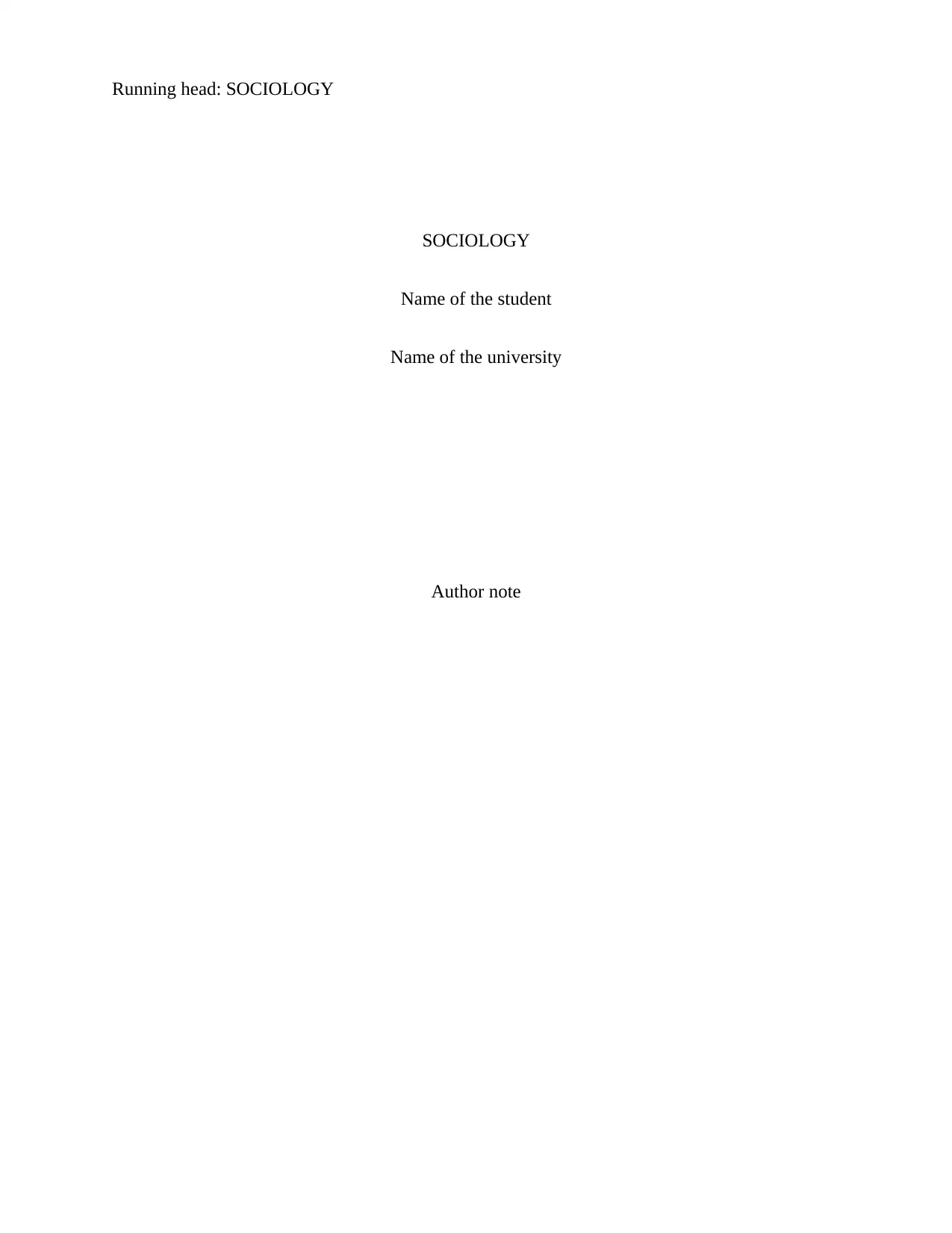
Running head: SOCIOLOGY
SOCIOLOGY
Name of the student
Name of the university
Author note
SOCIOLOGY
Name of the student
Name of the university
Author note
Paraphrase This Document
Need a fresh take? Get an instant paraphrase of this document with our AI Paraphraser
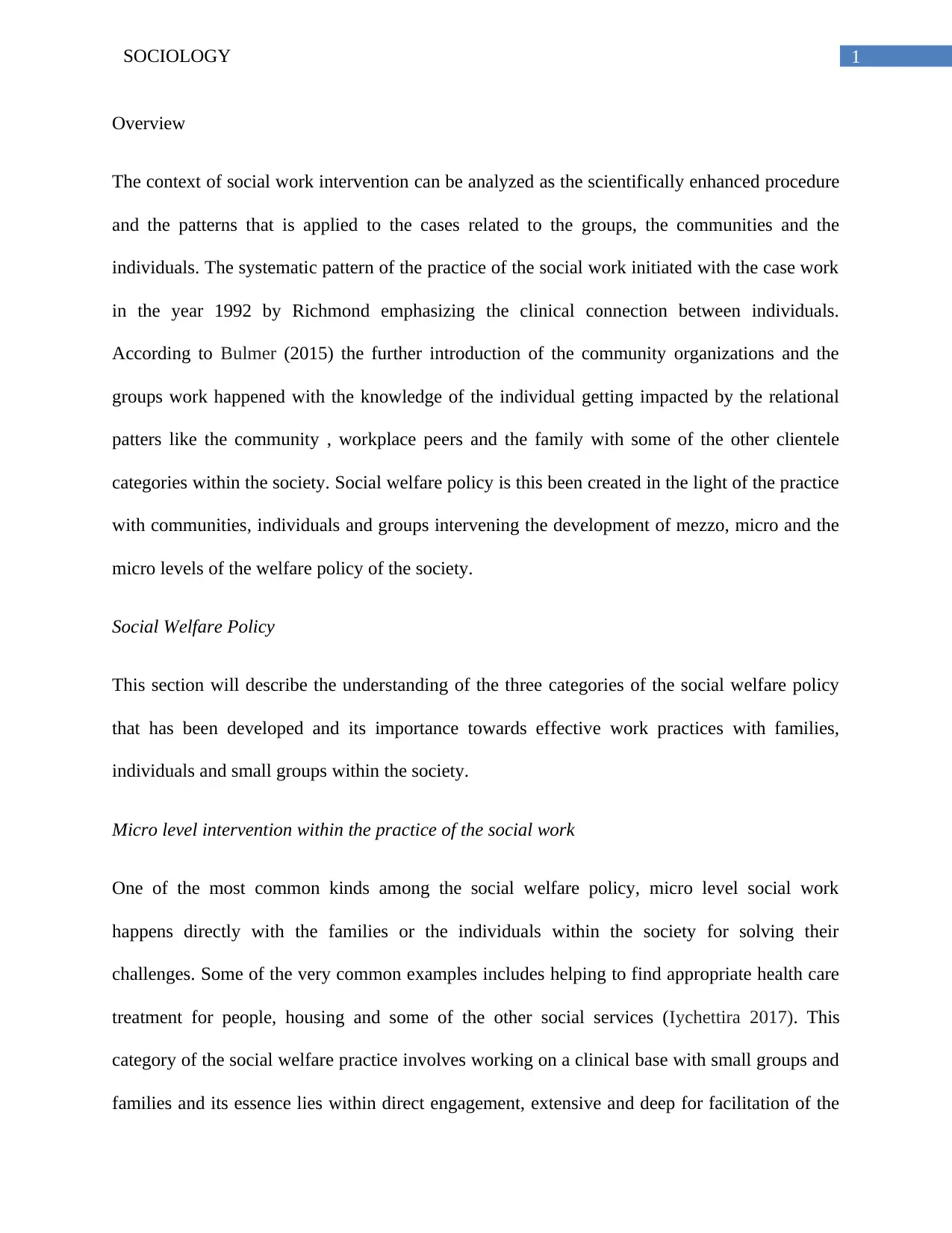
1SOCIOLOGY
Overview
The context of social work intervention can be analyzed as the scientifically enhanced procedure
and the patterns that is applied to the cases related to the groups, the communities and the
individuals. The systematic pattern of the practice of the social work initiated with the case work
in the year 1992 by Richmond emphasizing the clinical connection between individuals.
According to Bulmer (2015) the further introduction of the community organizations and the
groups work happened with the knowledge of the individual getting impacted by the relational
patters like the community , workplace peers and the family with some of the other clientele
categories within the society. Social welfare policy is this been created in the light of the practice
with communities, individuals and groups intervening the development of mezzo, micro and the
micro levels of the welfare policy of the society.
Social Welfare Policy
This section will describe the understanding of the three categories of the social welfare policy
that has been developed and its importance towards effective work practices with families,
individuals and small groups within the society.
Micro level intervention within the practice of the social work
One of the most common kinds among the social welfare policy, micro level social work
happens directly with the families or the individuals within the society for solving their
challenges. Some of the very common examples includes helping to find appropriate health care
treatment for people, housing and some of the other social services (Iychettira 2017). This
category of the social welfare practice involves working on a clinical base with small groups and
families and its essence lies within direct engagement, extensive and deep for facilitation of the
Overview
The context of social work intervention can be analyzed as the scientifically enhanced procedure
and the patterns that is applied to the cases related to the groups, the communities and the
individuals. The systematic pattern of the practice of the social work initiated with the case work
in the year 1992 by Richmond emphasizing the clinical connection between individuals.
According to Bulmer (2015) the further introduction of the community organizations and the
groups work happened with the knowledge of the individual getting impacted by the relational
patters like the community , workplace peers and the family with some of the other clientele
categories within the society. Social welfare policy is this been created in the light of the practice
with communities, individuals and groups intervening the development of mezzo, micro and the
micro levels of the welfare policy of the society.
Social Welfare Policy
This section will describe the understanding of the three categories of the social welfare policy
that has been developed and its importance towards effective work practices with families,
individuals and small groups within the society.
Micro level intervention within the practice of the social work
One of the most common kinds among the social welfare policy, micro level social work
happens directly with the families or the individuals within the society for solving their
challenges. Some of the very common examples includes helping to find appropriate health care
treatment for people, housing and some of the other social services (Iychettira 2017). This
category of the social welfare practice involves working on a clinical base with small groups and
families and its essence lies within direct engagement, extensive and deep for facilitation of the
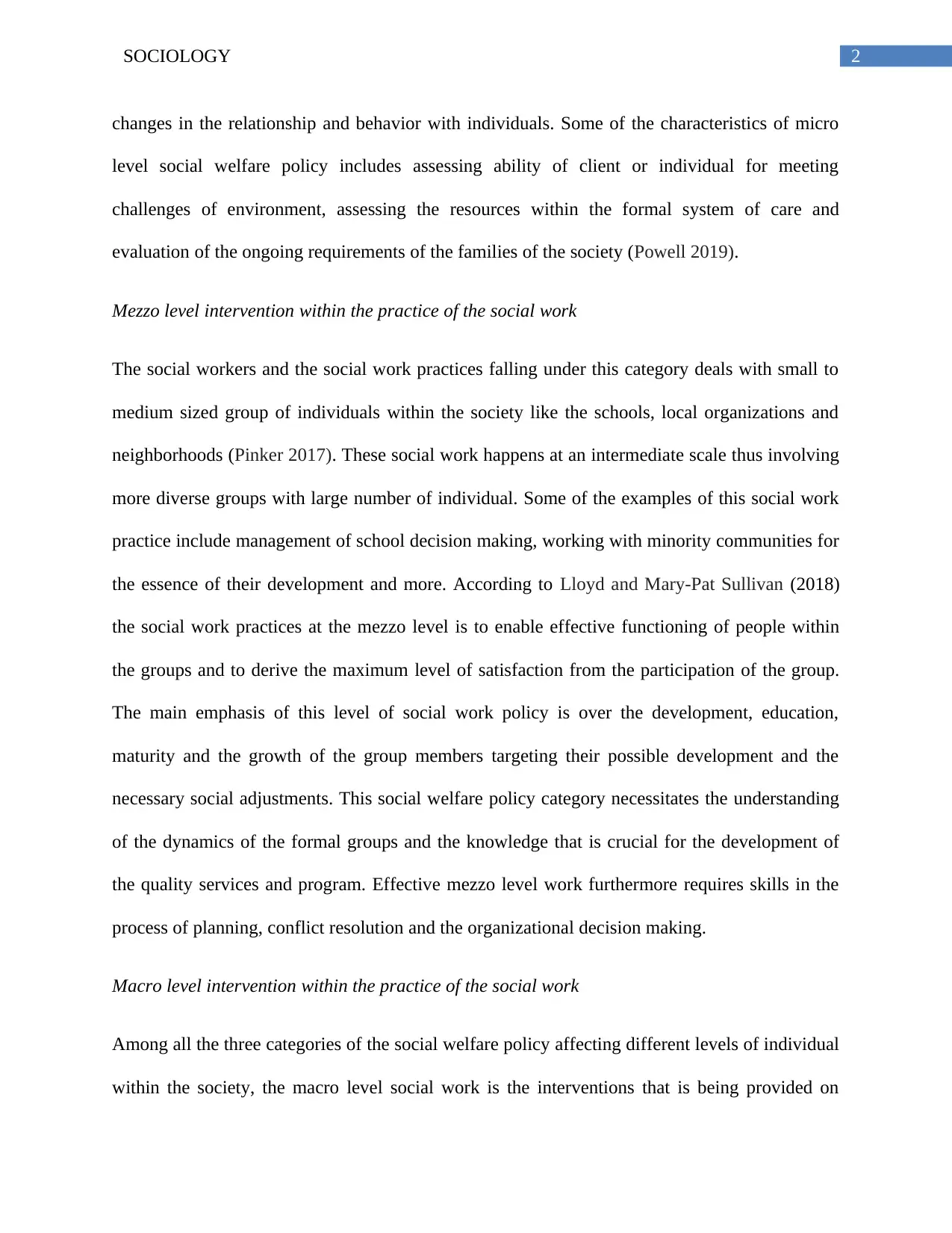
2SOCIOLOGY
changes in the relationship and behavior with individuals. Some of the characteristics of micro
level social welfare policy includes assessing ability of client or individual for meeting
challenges of environment, assessing the resources within the formal system of care and
evaluation of the ongoing requirements of the families of the society (Powell 2019).
Mezzo level intervention within the practice of the social work
The social workers and the social work practices falling under this category deals with small to
medium sized group of individuals within the society like the schools, local organizations and
neighborhoods (Pinker 2017). These social work happens at an intermediate scale thus involving
more diverse groups with large number of individual. Some of the examples of this social work
practice include management of school decision making, working with minority communities for
the essence of their development and more. According to Lloyd and Mary-Pat Sullivan (2018)
the social work practices at the mezzo level is to enable effective functioning of people within
the groups and to derive the maximum level of satisfaction from the participation of the group.
The main emphasis of this level of social work policy is over the development, education,
maturity and the growth of the group members targeting their possible development and the
necessary social adjustments. This social welfare policy category necessitates the understanding
of the dynamics of the formal groups and the knowledge that is crucial for the development of
the quality services and program. Effective mezzo level work furthermore requires skills in the
process of planning, conflict resolution and the organizational decision making.
Macro level intervention within the practice of the social work
Among all the three categories of the social welfare policy affecting different levels of individual
within the society, the macro level social work is the interventions that is being provided on
changes in the relationship and behavior with individuals. Some of the characteristics of micro
level social welfare policy includes assessing ability of client or individual for meeting
challenges of environment, assessing the resources within the formal system of care and
evaluation of the ongoing requirements of the families of the society (Powell 2019).
Mezzo level intervention within the practice of the social work
The social workers and the social work practices falling under this category deals with small to
medium sized group of individuals within the society like the schools, local organizations and
neighborhoods (Pinker 2017). These social work happens at an intermediate scale thus involving
more diverse groups with large number of individual. Some of the examples of this social work
practice include management of school decision making, working with minority communities for
the essence of their development and more. According to Lloyd and Mary-Pat Sullivan (2018)
the social work practices at the mezzo level is to enable effective functioning of people within
the groups and to derive the maximum level of satisfaction from the participation of the group.
The main emphasis of this level of social work policy is over the development, education,
maturity and the growth of the group members targeting their possible development and the
necessary social adjustments. This social welfare policy category necessitates the understanding
of the dynamics of the formal groups and the knowledge that is crucial for the development of
the quality services and program. Effective mezzo level work furthermore requires skills in the
process of planning, conflict resolution and the organizational decision making.
Macro level intervention within the practice of the social work
Among all the three categories of the social welfare policy affecting different levels of individual
within the society, the macro level social work is the interventions that is being provided on
⊘ This is a preview!⊘
Do you want full access?
Subscribe today to unlock all pages.

Trusted by 1+ million students worldwide
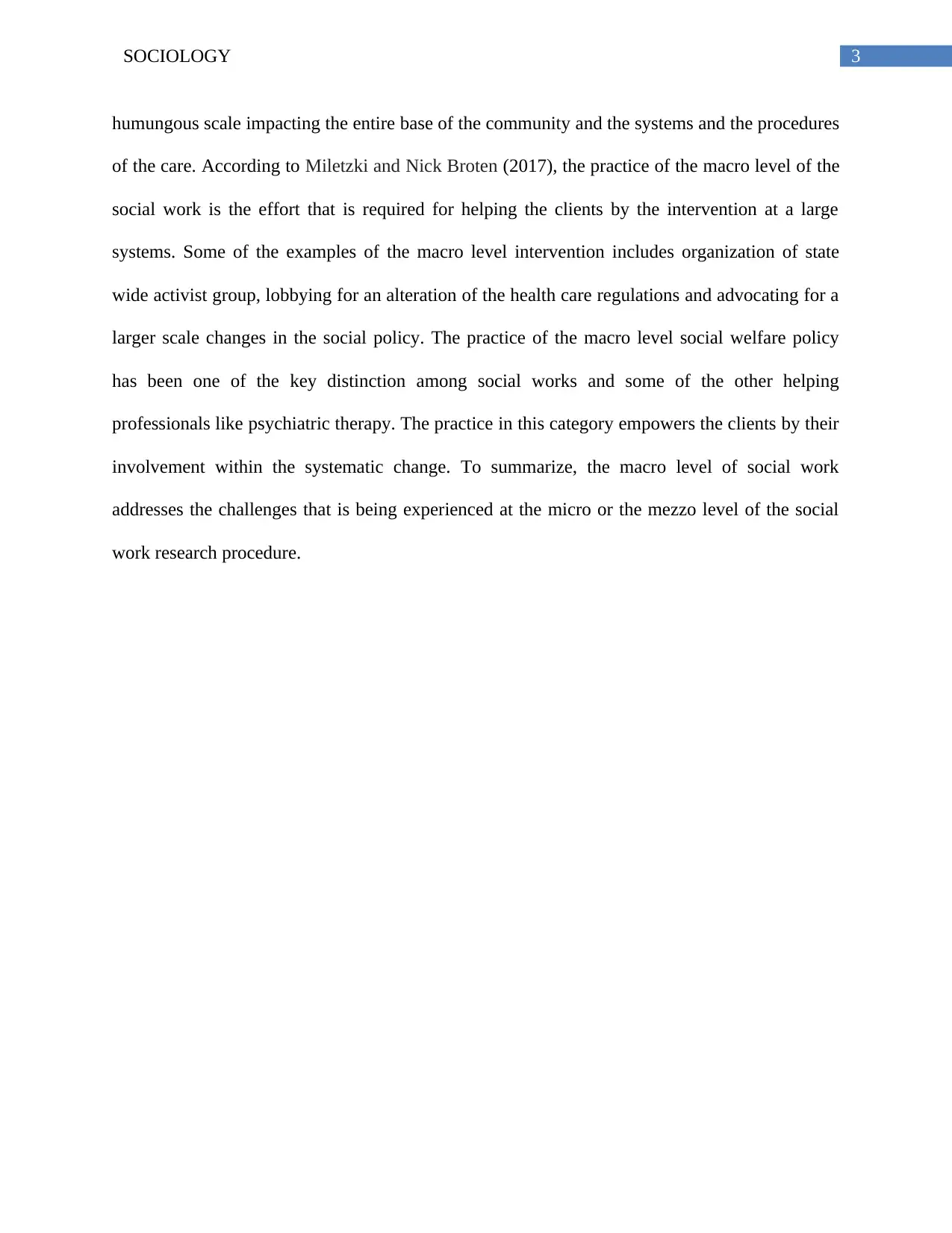
3SOCIOLOGY
humungous scale impacting the entire base of the community and the systems and the procedures
of the care. According to Miletzki and Nick Broten (2017), the practice of the macro level of the
social work is the effort that is required for helping the clients by the intervention at a large
systems. Some of the examples of the macro level intervention includes organization of state
wide activist group, lobbying for an alteration of the health care regulations and advocating for a
larger scale changes in the social policy. The practice of the macro level social welfare policy
has been one of the key distinction among social works and some of the other helping
professionals like psychiatric therapy. The practice in this category empowers the clients by their
involvement within the systematic change. To summarize, the macro level of social work
addresses the challenges that is being experienced at the micro or the mezzo level of the social
work research procedure.
humungous scale impacting the entire base of the community and the systems and the procedures
of the care. According to Miletzki and Nick Broten (2017), the practice of the macro level of the
social work is the effort that is required for helping the clients by the intervention at a large
systems. Some of the examples of the macro level intervention includes organization of state
wide activist group, lobbying for an alteration of the health care regulations and advocating for a
larger scale changes in the social policy. The practice of the macro level social welfare policy
has been one of the key distinction among social works and some of the other helping
professionals like psychiatric therapy. The practice in this category empowers the clients by their
involvement within the systematic change. To summarize, the macro level of social work
addresses the challenges that is being experienced at the micro or the mezzo level of the social
work research procedure.
Paraphrase This Document
Need a fresh take? Get an instant paraphrase of this document with our AI Paraphraser
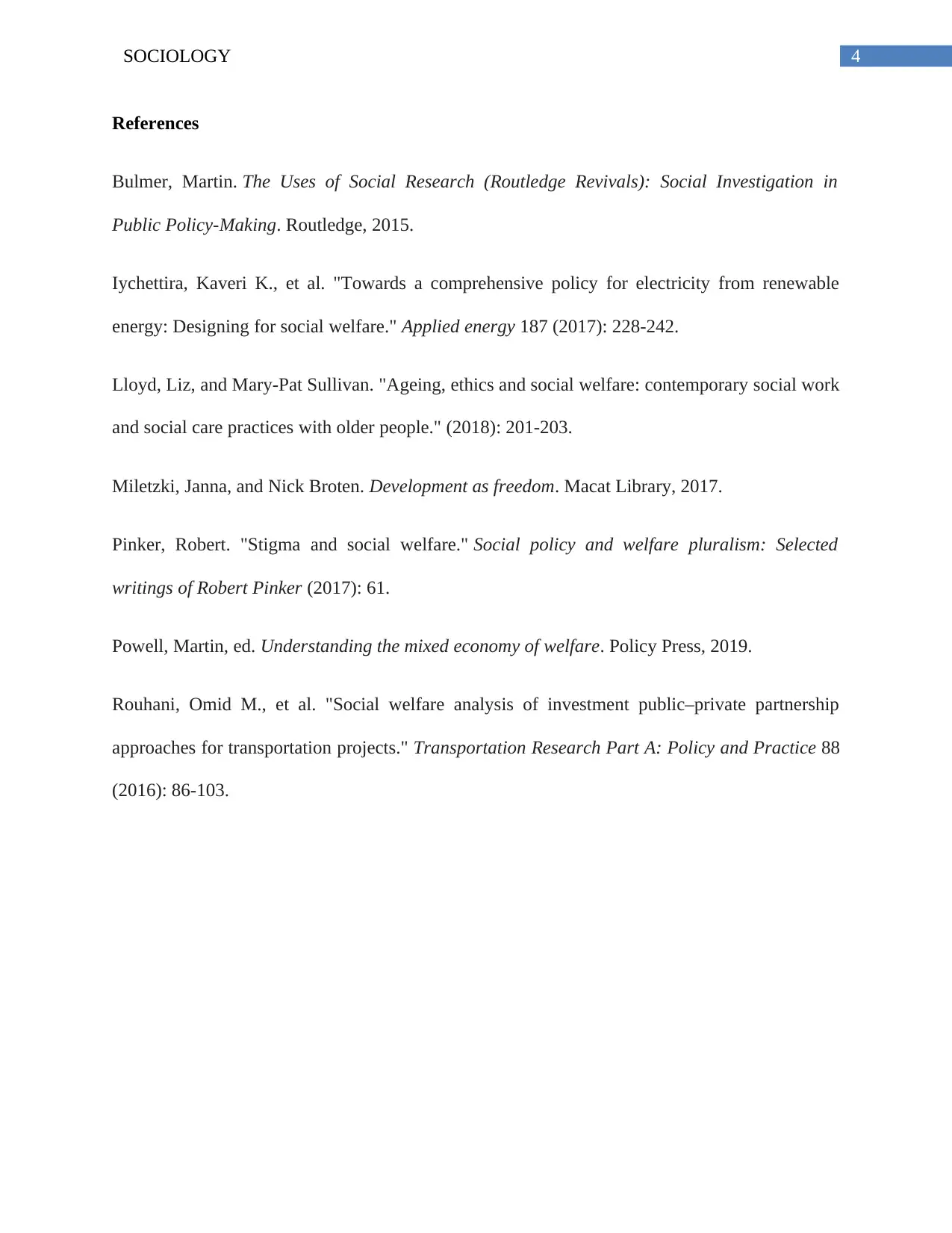
4SOCIOLOGY
References
Bulmer, Martin. The Uses of Social Research (Routledge Revivals): Social Investigation in
Public Policy-Making. Routledge, 2015.
Iychettira, Kaveri K., et al. "Towards a comprehensive policy for electricity from renewable
energy: Designing for social welfare." Applied energy 187 (2017): 228-242.
Lloyd, Liz, and Mary-Pat Sullivan. "Ageing, ethics and social welfare: contemporary social work
and social care practices with older people." (2018): 201-203.
Miletzki, Janna, and Nick Broten. Development as freedom. Macat Library, 2017.
Pinker, Robert. "Stigma and social welfare." Social policy and welfare pluralism: Selected
writings of Robert Pinker (2017): 61.
Powell, Martin, ed. Understanding the mixed economy of welfare. Policy Press, 2019.
Rouhani, Omid M., et al. "Social welfare analysis of investment public–private partnership
approaches for transportation projects." Transportation Research Part A: Policy and Practice 88
(2016): 86-103.
References
Bulmer, Martin. The Uses of Social Research (Routledge Revivals): Social Investigation in
Public Policy-Making. Routledge, 2015.
Iychettira, Kaveri K., et al. "Towards a comprehensive policy for electricity from renewable
energy: Designing for social welfare." Applied energy 187 (2017): 228-242.
Lloyd, Liz, and Mary-Pat Sullivan. "Ageing, ethics and social welfare: contemporary social work
and social care practices with older people." (2018): 201-203.
Miletzki, Janna, and Nick Broten. Development as freedom. Macat Library, 2017.
Pinker, Robert. "Stigma and social welfare." Social policy and welfare pluralism: Selected
writings of Robert Pinker (2017): 61.
Powell, Martin, ed. Understanding the mixed economy of welfare. Policy Press, 2019.
Rouhani, Omid M., et al. "Social welfare analysis of investment public–private partnership
approaches for transportation projects." Transportation Research Part A: Policy and Practice 88
(2016): 86-103.
1 out of 5
Related Documents
Your All-in-One AI-Powered Toolkit for Academic Success.
+13062052269
info@desklib.com
Available 24*7 on WhatsApp / Email
![[object Object]](/_next/static/media/star-bottom.7253800d.svg)
Unlock your academic potential
Copyright © 2020–2025 A2Z Services. All Rights Reserved. Developed and managed by ZUCOL.





